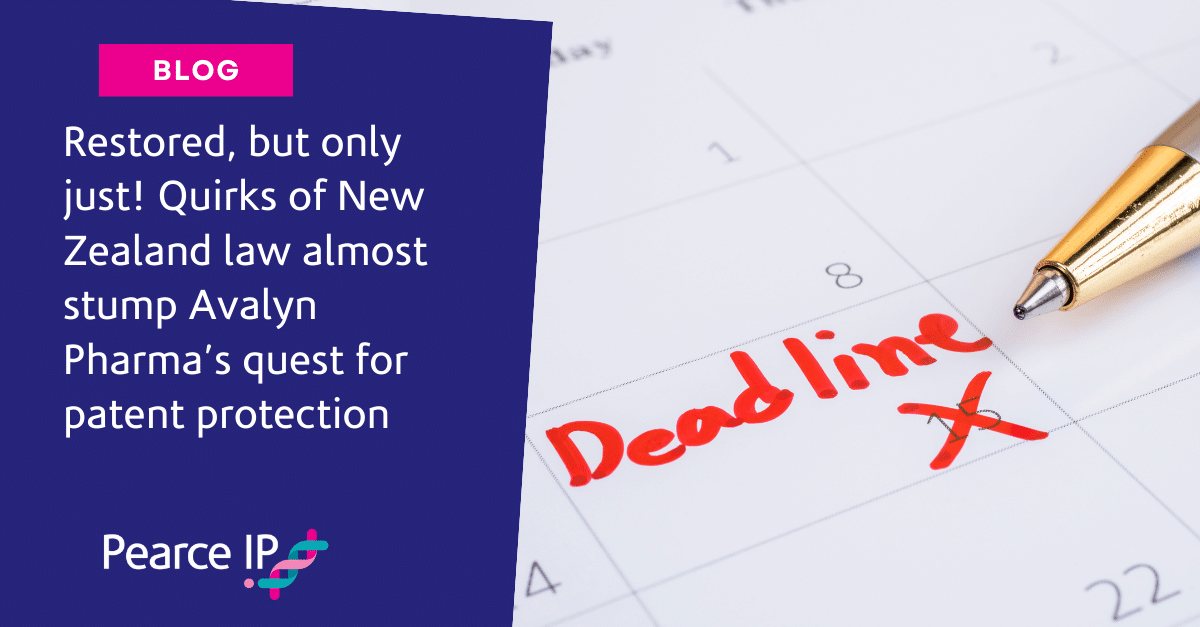Date: 14 February 2024
Court: Intellectual Property Office of New Zealand
Adjudicator: Warren Coles, Assistant Commissioner of Patents
Date:
Court:
Adjudicator:
14 February 2024
Intellectual Property Office of New Zealand
Warren Coles, Assistant Commissioner of Patents
The sequence of events set out in the decision in Avalyn Pharma, Inc. [2024] NZIPOPAT 4 (Avalyn) provides a good example of the importance of understanding the nuances of patent practice in New Zealand. In particular, New Zealand law provides staggered deadlines for responding to an examination report. The law also provides a finite window of opportunity for seeking patent protection under a divisional application, which can abruptly compress depending on progress made during prosecution. A clear understanding of deadlines is therefore critical when developing a New Zealand-specific patenting strategy.
Prosecution and divisional practice in New Zealand
Deadlines during New Zealand patent prosecution can be complex. Once a standard patent application is filed in New Zealand, examination must be requested on or before a deadline of 5 years after the effective filing date. For a PCT application entering national phase in New Zealand, the deadline for requesting examination is 5 years after the international filing date. Additionally, the issuance of a first examination report sets a 12 month, non-extendible acceptance deadline. However, the date of the first report also sets in place a 6 month deadline to file a response, which is extendible by 1 month on written request. For a subsequent examination report, the response deadline is 3 months from the date of the examination report, extendible by 1 month on written request.
There are also several overlapping criteria for validly seeking protection under a divisional patent application in New Zealand. These include, but are not limited to the following:
- A divisional application must be filed while the parent is pending and before the parent application is accepted.
- All divisional applications must be filed within 5 years from the effective filing date of the parent.
- A request for examination of any and all divisional applications must be made on or before the 5 year deadline set in respect of the parent.
The facts of Avalyn
Avalyn Pharma, Inc.’s New Zealand Application No. 717528 (NZ 717528) is a national phase application derived from PCT Application No. PCT/US2014/049294. In this case, the attorney responsible for directing global patent prosecution was based in the US, and the attorney handling the New Zealand prosecution was a Trans-Tasman patent attorney based in Australia.[1]
A request for examination for NZ 717528 was filed on 31 July 2019, which was the 5 year deadline as calculated from the effective filing date. A divisional application was not filed at that time. A first examination report issued with a response deadline of 17 December 2021, extendible to 17 January 2021. Due to a series of docketing errors in the US, the examination response deadline was not met and NZ 717528 became abandoned. A request for extension of time to respond to the examination report was made but rejected by the New Zealand Patent Office.
A request for restoration of NZ 717528 was then filed with statutory declarations from both the US and Australian attorneys with supporting evidence. The declarations indicated that the US patent attorney did not have a clear understanding of the non-extendible 5 year deadline to file a divisional application in New Zealand. This misunderstanding was compounded when the Australian attorney erroneously reported that a divisional application could be filed after the 5 year deadline, although this error was subsequently corrected. In any event, this lack of understanding and miscommunication resulted in the response deadline being removed from the US attorney’s records. The evidence indicated that the US attorney relied on being able to file a divisional application while the parent was pending to maintain rights.
After consideration of all the evidence, the Examiner determined that it was Avalyn’s intention to abandon NZ 717528 in favour of a divisional application, and so NZ 717528 should not be restored. Primarily, the determination of intent was based on the US attorney’s records which effectively marked NZ 717528 as abandoned while adding the divisional application. The Examiner determined that a misunderstanding of the deadlines did not constitute an unintentional failure as required for restoration.
This decision was reversed by the Assistant Commissioner after a hearing. The Assistant Commissioner found that there was no overall intent to abandon the family, and that NZ 717528 should be restored. He focused on the intent of Avalyn instead of the US or Australian attorney.
Key to the Assistant Commissioner’s decision was evidence from Avalyn that its global patent strategy required filing of divisional applications, and that it had never instructed abandonment of any application in the global patent family, including this one. Noting Avalyn’s lack of intent to abandon NZ 717528, the Assistant Commissioner was satisfied that the request for restoration should be granted providing a further 1 month to achieve acceptance.
Key takeaways
This case highlights the unique aspects of New Zealand patent practice, emphasising the importance of having a clear divisional strategy and corresponding accurate deadline monitoring systems, and that there can be extensive steps required to achieve restoration where a patent application is inadvertently abandoned.
As an aside, while not explored in the decision, the fact that a 1 month extension was granted to pursue acceptance of NZ 717528 still would not provide Avalyn with the opportunity to validly file a divisional application. A separate extension of time request is required to file a divisional application, and while such extensions are difficult to obtain, Avalyn may be in a position to obtain an extension based on this decision.
[1] Under a bilateral agreement between Australia and New Zealand, Trans-Tasman patent attorneys are able to practise before both the Australian and New Zealand patent offices.
About Pearce IP
Pearce IP is a boutique firm offering intellectual property specialist lawyers, patent attorneys and trade mark attorneys to the life sciences industries (in particular, pharmaceutical, biopharmaceutical, biotech, ag-tech and food tech). Pearce IP is the 2021 ‘Intellectual Property Team of the Year’ (Lawyers Weekly Australian Law Awards) and was shortlisted for the same award in 2022. Pearce IP is ranked in IAM Patent 1000 and Managing IP (MIP) IP Stars, in Australasian Lawyer 5 Star Awards as a ‘5 Star’ firm, and the Legal 500 APAC Guide for Intellectual Property.
Our leaders have been recognised in virtually every notable IP listing for their legal, patent and trade mark excellence including: IAM Patent 1000, IAM Strategy 300, MIP IP Stars, Doyles Guide, WIPR Leaders, 5 Star IP Lawyers, Best Lawyers, and Australasian Lawyer 5 Star Awards, and have been honoured with many awards including Australian Law Awards – IP Partner of the Year, Women in Law Awards – Partner of the Year, Women in Business Law Awards – Patent Lawyer of the Year (Asia Pacific), Most Influential Lawyers (Changemaker), among other awards.

Julie Ballance
Executive, Patent Attorney & Trade Mark Practitioner (AU, NZ), Lawyer & Notary (NZ)
Julie is a senior Trans-Tasman patent attorney, and a New Zealand registered lawyer and notary public with more than 30 years’ experience across a range of technology areas and a first class honours degree in chemistry. Julie is internationally renowned for her considerable patent/trade mark/designs/legal prowess, including being ranked in IAM Patent 1000.

